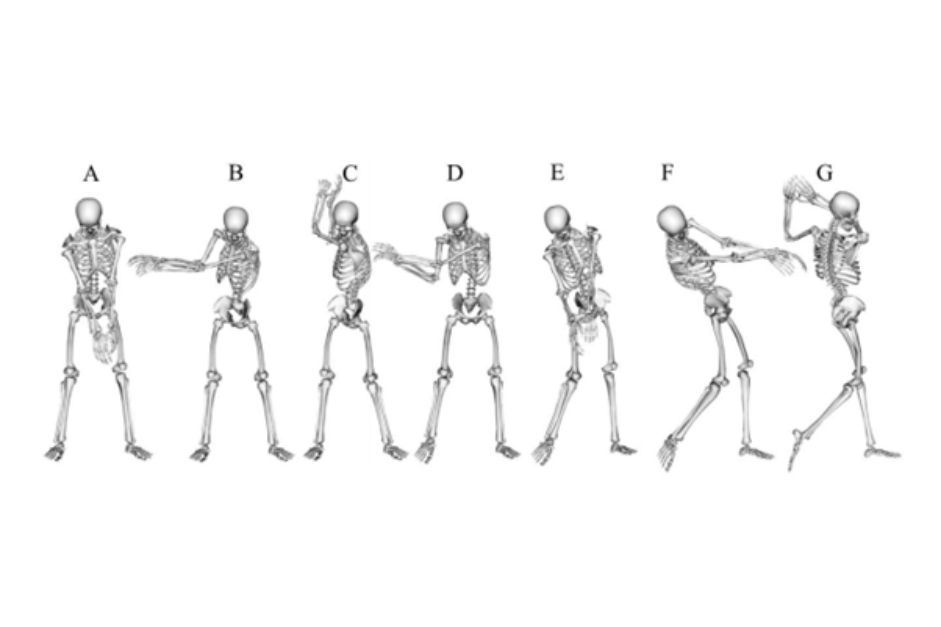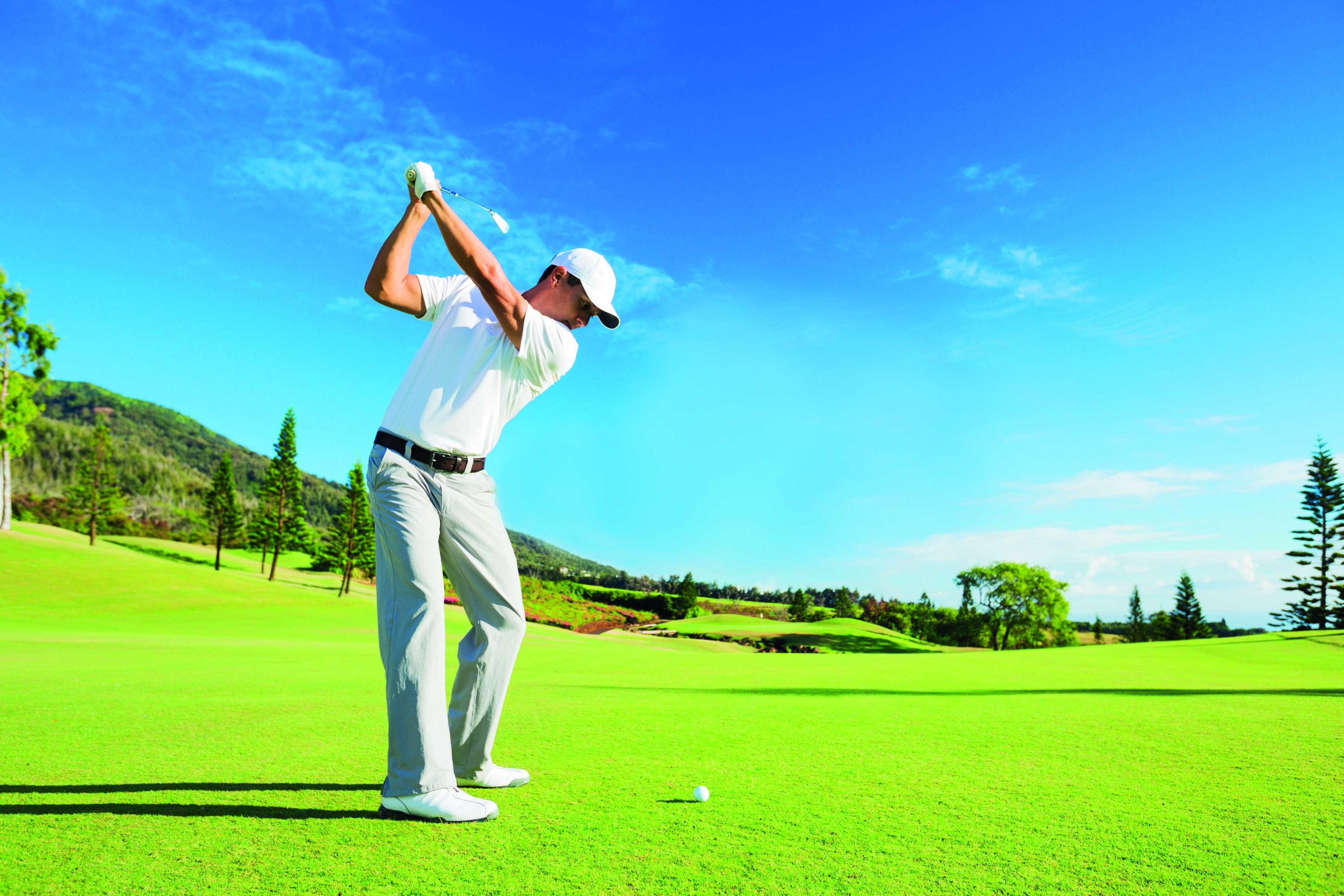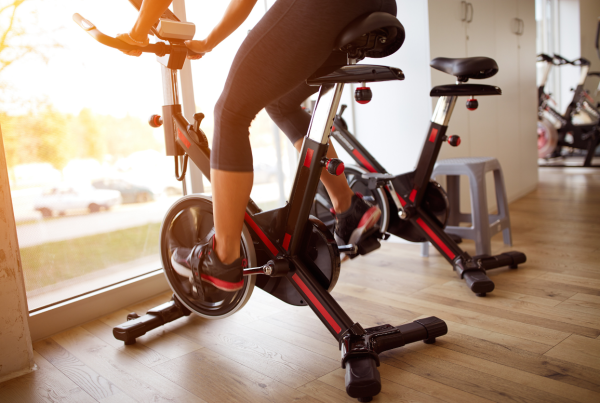Strength and conditioning for the golf swing. In part one of this two-part series by UKSCA looking at strength and conditioning for golf, we explore developing the golf swing.
The main objective of golf is to hit a ball into an ordered series of holes on a course (often 18 holes) using a range of clubs. It is a highly technical and skill-based sport. The winner is the player who completes the course in the fewest shots. According to Shaw, the golf swing is regarded as “one of the most complex sporting movements”1 and may be broadly divided into five phases: address, backswing, downswing, impact and follow-through (see Figure 1)1,2.
Driving distance and shot accuracy are the two main factors that affect a golfer’s swing performance4. Each shot’s outcome and the possibility of a favourable follow-through shot are based on the golf ball’s final position (displacement)5. The distance that the ball travels from impact to landing or carry distance (CD)6, is influenced by swing parameters such as ball speed (BS) and club head speed (CHS: the speed of the golf club head at the point of ball impact)1,6.
“Professional golfers can hit more than 2,000 shots a week and execute up to 300 swings in a single practice session”
Given that longer drives are associated with better scores and overall golf performance2, elite golfers frequently use strength and conditioning (S&C) interventions aimed at increasing CHS and BS. A recent study found that 78.5% of highly skilled golfers participated in S&C training at some point during the season7; therefore, understanding the physical factors that contribute to the major phases of the golf swing is crucial for S&C Trainers in order to effectively programme interventions for players.

Figure 1. Golf swing sequence, at different instants: address (A), mid-backswing (B), top of backswing (C), mid-downswing (D), impact (E), mid-follow-thorough (F), finish (G). (Adapted from Bourgain et al, 2022)3
Key areas for development are:
-
Muscle strength
The summation of speed concept states that, in order to achieve maximum speed – in this case, to accelerate the club head through the impact phase of the golf swing – movement patterns should begin with the larger, more proximal muscles (i.e., the lower body) initiating the action and then shifting the force to the smaller, more distal muscles, increasing the movement’s speed as they do so8.
In order for the linkage between the upper and lower body segments to effectively transfer kinetic energy to the ball, large ground reaction forces (up to 1.5 to 2.0 x bodyweight)9 produced by the lower body initiate the golf swing10. These forces transition from the rear leg during the backswing to the lead leg during the downswing. After the lower body produces force, it travels through the trunk, the shoulders and the arms along the kinetic chain1,2.
-
Rate of force development
Due to the short downswing (0.3 seconds), increasing the rate of force development (RFD) may be more beneficial for enhancing golf performance than raising the peak force due to the golf swing’s velocity1,6. However, high levels of strength are a must for developing high-velocity, force-producing skills, therefore, it should not be overlooked that strength underpins RFD11.
-
Balance
According to Sheehan et al6, balance – more especially, single-leg balance – is crucial to golf performance because players with greater stability are better able to manage challenging stance postures and the weight transfers that occur during the swing.
“The way the thoracic spine rotates during the peak of the backswing is known as the “X-Factor””
-
Flexibility
The way the thoracic spine rotates in respect to the pelvis during the peak of the backswing is known as the “X-Factor”12. The X-Factor stretch that is produced at the beginning of the downswing, when the pelvis starts to rotate back towards the target while the upper body momentarily stagnates, is thought to allow a stretch-shortening cycle effect that facilitates faster CHS1,12. Additionally, when producing the “X-Factor”, flexibility may help to generate more force over a wider range of motion. This would provide a longer backswing and more time to achieve higher angles, velocities and CHS6.
To sum up, S&C Trainers must focus on strength and RFD of the upper, mid-section (i.e., core) and lower body, as well as joint flexibility and balance to increase the X-Factor, in order to optimise training for golfers. This will enhance CHS and shot distance.
Golfers should engage in structured S&C programmes for additional reasons, such as the elimination of physical limitations that impede their technique and raise their risk of injury, so that they can continue training and competing throughout the extended season.
Golfers practise an asymmetrical skill, or a movement pattern that can only be done one way, for several hours a day. Professional golfers can hit more than 2,000 shots a week and execute up to 300 swings in a single practice session13. It is crucial that a golfer is ready to withstand the volume of these repeating forces to ensure they can fulfil the demands of playing tournament golf, both mentally and physically, and prevent the negative impacts of fatigue and injury.
What is a physical development model?
A physical development model has always involved prioritising the development of broad physical foundations for success over early, excessively specialised golf S&C training, which frequently happens too early in a golfer’s career.
A physical development model for training outlines structured stages of physical growth and skill acquisition in athletes or individuals. It provides a systematic approach to developing strength, endurance, flexibility and other physical attributes. This model ensures training is age-appropriate, progressive and tailored to an individual’s needs, promoting optimal performance and reducing the risk of injury14.
Having such a model is crucial as it helps S&C Trainers and coaches design effective programmes that enhance physical capabilities, support long-term athletic development, and ensure sustainable progress towards fitness and performance goals15. Furthermore, a well-structured model considers critical periods of development, allowing for the optimisation of training interventions during windows of accelerated adaptation.
However, there is more to a player development framework aside from developing physical qualities, especially when working with youth athletes. Professional habits and psychological perspectives are pivotal and need to be purposefully developed through the stages of player development.
Professional habits encompass structured routines, including regular training, disciplined nutrition, adequate sleep and recovery protocols. These habits foster consistency, resilience and peak physical performance. Additionally, athletes benefit from meticulous time management, goal-setting and self-reflection to continually refine their skills and address weaknesses.
Psychologically, developing mental toughness, stress management and emotional intelligence is crucial. Athletes must cultivate a growth mindset, embracing challenges and learning from failures. Building confidence, focus and motivation are also integral, often supported by an S&C Trainer. Effective communication skills, teamwork and maintaining a healthy work-life balance contribute to overall wellbeing.
Lastly, athletes should be adept at coping with pressure and setbacks, ensuring a holistic approach to their development that encompasses both physical prowess and mental fortitude. This comprehensive and holistic approach to athlete development, including physical, technical, tactical and psychological aspects will ultimately lead to well-rounded, resilient athletes. It also facilitates monitoring and adjusting training loads to prevent burnout and overtraining, contributing to sustained athletic careers and overall wellbeing16.
Part two in this series will provide an example of a Golf Physical Development Framework, including age- and stage-appropriate example S&C programmes.

Debby Sargent
Debby Sargent currently works at the University of Gloucestershire (UoG) delivering undergraduate and postgraduate strength and conditioning courses. She has over 20 years of experience working with high-performance athletes and has been a UKSCA tutor and assessor since 2008.

Chris Simpson
Chris Simpson MSc, ASCC currently works across several organisations: Montrose FC 1st Team sports scientist, performance coach at TRAAINER, lead S&C coach at Scottish Golf, lecturer at Dundee and Angus College and co-director at Fit 4 Purpose (Angus).
Look out for part two in this series in the next issue of the FitPro Edit. Sign up to the FitPro newsletter here so you don’t miss it.
Read more about training for golf on the FitPro blog.
References
- Shaw J, Gould ZI, Oliver JL, Lloyd RS (2022), Physical determinants of golf swing performance: Considerations for youth golfers, Strength & Conditioning Journal, 44(4): 10-21.
- Jones B, Stevenson G (2015), Strength and power training for golf players, Professional Strength and Conditioning, 38: 17-26.
- Bourgain M, Rouch P, Rouillon O, Thoreux P, Sauret C (2022), Golf swing biomechanics: A systematic review and methodological recommendations for kinematics, Sports, 10(6): 91.
- Ehlert A (2020), The effects of strength and conditioning interventions on golf performance: A systematic review, Journal of Sports Sciences, 38(23): 2,720-31.
- Parker J, Hellström J, Olsson MC (2022), Differences in kinematics and driver performance in elite female and male golfers, Sports Biomechanics, 21(6): 731-47.
- Sheehan WB, Bower RG, Watsford ML (2022), Physical determinants of golf swing performance: A review, The Journal of Strength & Conditioning Research, 36(1): 289-97.
- Wells JE, Langdown BL (2020), Sports science for golf: A survey of high-skilled golfers’ “perceptions” and “practices”, Journal of Sports Sciences, 38(8): 918-27.
- Bunn JW (1972), Scientific Principles of Coaching.
- Hume PA, Keogh J, Reid D (2005), The role of biomechanics in maximising distance and accuracy of golf shots, Sports Medicine, 35: 429-49.
- Tinmark F, Hellström J, Halvorsen K, Thorstensson A (2010), Elite golfers’ kinematic sequence in full-swing and partial-swing shots, Sports Biomechanics, 9(4): 236-44.
- Suchomel TJ, Nimphius S, Bellon CR, Stone MH (2018), The importance of muscular strength: Training considerations, Sports Medicine, 48: 765-85.
- Bishop C, Ehlert A, Wells J, Brearley S, Brennan A, Coughlan D (2022), Strength and conditioning for golf athletes: Biomechanics, injury risk, physical requirements, and recommendations for testing and training, Professional Strength and Conditioning, (64): 7-18.
- Evans K, Tuttle N (2015), Improving performance in golf: Current research and implications from a clinical perspective, Brazilian Journal of Physical Therapy, 19: 381-9.
- Lloyd RS, Cronin JB, Faigenbaum AD, Haff GG, Howard R, Kraemer WJ, Micheli LJ, Myer GD and Oliver JL (2016), National Strength and Conditioning Association position statement on long-term athletic development, The Journal of Strength & Conditioning Research, 30(6): 1,491-1,509.
- Balyi I, Way R, Higgs C (2013), Long-term Athlete Development, Human Kinetics.
- Vaeyens R, Lenoir M, Williams AM, Philippaerts RM (2008), Talent identification and development programmes in sport: Current models and future directions, Sports Medicine, 38: 703-14.







